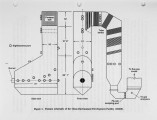| Title |
Full-Size Characterization of Low-NOx Burner Coal Nozzle Mixing Devices in a 100 MBtu/hr Research Facility |
| Creator |
Sarv, Hamid; LaRue, Albert D. |
| Publisher |
Digitized by J. Willard Marriott Library, University of Utah |
| Date |
1995 |
| Spatial Coverage |
presented at Monterey, California |
| Abstract |
Reduction of unburned carbon levels for coal burning power plants that are equipped with 10w-NOx burners decreases fuel costs, and facilitates fly ash recycling and disposal. For this purpose, Babcock and Wilcox (B&W) has developed a proprietary coal nozzle mixing device to install in commercial low-NOx pulverized coal (PC) burners. Combustion and emissions performance of a full-size, 100 million Btu/hr (MBtu/hr), DRB-XCL® 10w-NOx PC burner and the proprietary device was characterized in the Clean Environment Development Facility at B&W with four different fuels ranging from subbituminous to low volatile bituminous coals. Experimental parameters included coal fineness, excess air, and thermal load. Relative to the baseline 10w-NOx burner, the coal nozzle device produced shorter flames and lower unburned carbon levels, while maintaining low NOx emissions. Retrofit plans for commercial installations are underway. |
| Type |
Text |
| Format |
application/pdf |
| Language |
eng |
| Rights |
This material may be protected by copyright. Permission required for use in any form. For further information please contact the American Flame Research Committee. |
| Conversion Specifications |
Original scanned with Canon EOS-1Ds Mark II, 16.7 megapixel digital camera and saved as 400 ppi uncompressed TIFF, 16 bit depth. |
| Scanning Technician |
Cliodhna Davis |
| ARK |
ark:/87278/s61v5hjq |
| Setname |
uu_afrc |
| ID |
7537 |
| Reference URL |
https://collections.lib.utah.edu/ark:/87278/s61v5hjq |


















